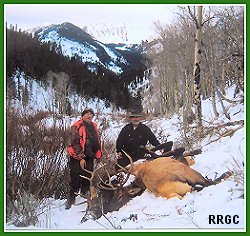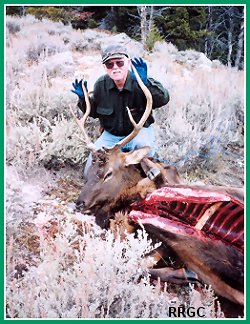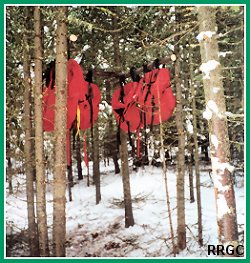Field Dressing Big Game
Capt. Lewis
Thursday August 1st 1805.
I ordered two of the men to skin the Elk and bring the meat to the river, while myself and the other prepared a fire and cooked some of the meat for our dinner. we made a comfortable meal on the Elk, and left the ballance of the meat and skins on the bank of the river for Capt. Clark and party. this supply will no doubt be acceptable to them, as they had had no fresh meat when I left them for almost 2 days except one beaver; game being very scarce and shy above the forks. to the river, while myself and the other prepared a fire and cooked some of the meat for our dinner. we made a comfortable meal on the Elk, and left the ballance of the meat and skins on the bank of the river for Capt. Clark and party. this supply will no doubt be acceptable to them, as they had had no fresh meat when I left them for almost 2 days except one beaver; game being very scarce and shy above the forks.
*
There are a number of judgment calls and trade-offs that need to be made to ensure the meat is kept clean, allowed to cool quickly, kept dry and well ventilated. Some hunters prefer to skin and quarter the animal immediately at the place of harvest. The meat is then placed in cloth meat bags to keep the meat clean during transport. This approach allows for quick cooling of the meat but it requires considerable care during the skinning operation to keep the meat clean. Other hunters have been equally successful in preventing meat spoilage by ensuring good ventilation and cooling of the meat without immediate skinning.
Field dressing of game is the first step in acquiring safe, clean meat and must be done as soon as possible after the game is harvested. The following items and equipment are necessary for field dressing:
 String or tape for tag attachment String or tape for tag attachment Sharp knives - skinning, boning and basic hunting knives Sharp knives - skinning, boning and basic hunting knives Saw/hatchet to split and quarter the animal. Saw/hatchet to split and quarter the animal. Cheese cloth type bags to cover the animal to keep flies off Cheese cloth type bags to cover the animal to keep flies off Ropes and pulleys for hanging the carcass and meat Ropes and pulleys for hanging the carcass and meat Cloth/cheese cloth game bags for boned meat or quarters Cloth/cheese cloth game bags for boned meat or quarters Cover cloth or natural material to exclude birds and small animals Cover cloth or natural material to exclude birds and small animals Rubber/latex gloves Rubber/latex gloves
Deer Size Animals (Deer, Antelope, Bighorn Sheep, Mountain Goats, average size Bears)
The first steps for deer size animals are as follows : :
 Put on rubber/latex gloves (protection against disease and contamination). Put on rubber/latex gloves (protection against disease and contamination). Remove all guts and organs from the carcass. Remove all guts and organs from the carcass. Clean the body cavity with a damp cloth to remove any blood or contamination. Clean the body cavity with a damp cloth to remove any blood or contamination.
If the carcass is to be left in the field over night and the weather is cool/windy, do the following:
 Cut the legs off at the knees. Cut the legs off at the knees. Spread the chest cavity with a stick to allow air circulation. Spread the chest cavity with a stick to allow air circulation. If possible using a rope/hoist, raise the carcass up ito a tree and cover with game/deer bags or after enclosing the carcass with a game bag place small logs or rocks under the carcass to allow air circulation. If possible using a rope/hoist, raise the carcass up ito a tree and cover with game/deer bags or after enclosing the carcass with a game bag place small logs or rocks under the carcass to allow air circulation. Once the carcass is at the hunting camp further field dressing may be required. Once the carcass is at the hunting camp further field dressing may be required.
If the weather is warm consider the following:
 If possible move the animal into shade near a large tree and hang it. If possible move the animal into shade near a large tree and hang it. If the animal is to be skinned, quartered or boned, cheese cloth type game bags should be available and ready for use. If the animal is to be skinned, quartered or boned, cheese cloth type game bags should be available and ready for use. Remove the hide and cover with a game bag or Remove the hide and cover with a game bag or  If there is sufficient time, and the meat is to be back packed out, or the day heat is a concern, boning should be considered. If there is sufficient time, and the meat is to be back packed out, or the day heat is a concern, boning should be considered. When boning, place the pieces in a cheese cloth type bag as they are removed to keep them clean. When boning, place the pieces in a cheese cloth type bag as they are removed to keep them clean. Boned meat laid on the ground or on three boughs will require time to clean during cutting and wrapping and may result in wasting some meat. Boned meat laid on the ground or on three boughs will require time to clean during cutting and wrapping and may result in wasting some meat. The process of boning will in itself allow sufficient cooling of the meat to minimize spoilage. The process of boning will in itself allow sufficient cooling of the meat to minimize spoilage. If the meat will be left in the field over night, If the meat will be left in the field over night,  tie the meat up off the ground in a shady area. tie the meat up off the ground in a shady area.
Other items to be considered to keep the meat clean, cool, dry and ventilated are:
 Do not place warm meat in plastic bags because they can trap heat and accelerate spoilage. Do not place warm meat in plastic bags because they can trap heat and accelerate spoilage. If the meat will remain at the hunting camp, hang bagged meat in the shade where there is good air circulation. If the meat will remain at the hunting camp, hang bagged meat in the shade where there is good air circulation.  If it warms up during the day the meat can be covered with a sleeping bag to minimize the possibility of warming up. If it warms up during the day the meat can be covered with a sleeping bag to minimize the possibility of warming up. Protect the meat from rain and never leave meat submerged in water for an extended period of time unless it has been cooled and is enclosed in a water tight bag. Protect the meat from rain and never leave meat submerged in water for an extended period of time unless it has been cooled and is enclosed in a water tight bag.
Large Animals (Elk, Mouse, Caribou, large Bears)
Gutting
If there are any trees or scrub brush available the legs can be tied to gain access to the abdominal cavity and facilitate gutting.
Skinning Using a Meat Pole ( remove the head from the animal)
 Saw down a 3-4 inch diameter tree long enough (at least 6 feet) to tie up between two larger trees as high as you can reach. Tie a hoist to one side of the pole. Saw down a 3-4 inch diameter tree long enough (at least 6 feet) to tie up between two larger trees as high as you can reach. Tie a hoist to one side of the pole. After removing all legs at the knee, tie one hind leg to the hoist, raise up to the pole and tie off. Repeat with the other hind leg and tie it off. After removing all legs at the knee, tie one hind leg to the hoist, raise up to the pole and tie off. Repeat with the other hind leg and tie it off.  Skin down to the third rib at the bottom of the rib cage. Skin down to the third rib at the bottom of the rib cage. Cut between the third and fourth ribs to the backbone on both sides and saw through the backbone. Cut between the third and fourth ribs to the backbone on both sides and saw through the backbone. Tie the hoist close to the side of the meat pole and cut a slot between the third and fourth ribs midway along the rib. Tie the hoist close to the side of the meat pole and cut a slot between the third and fourth ribs midway along the rib.  Tie one side of the hoist to one rib and repeat for the other. Tie one side of the hoist to one rib and repeat for the other.  Raise the rib cage to the pole and secure the hoist to prevent slippage. Raise the rib cage to the pole and secure the hoist to prevent slippage. Finish skinning the ribcage and neck. Finish skinning the ribcage and neck. The animal can now be quartered/boned. The animal can now be quartered/boned. If left in the field, the quarters or boned out meat must be covered with mesh type If left in the field, the quarters or boned out meat must be covered with mesh type cloth bag and positioned for good ventilation.
Skinning On the Ground
If there are any trees or brush available, the legs can be tied in different positions to aid skinning. It is best to skin one side and then the other. When finished, leave the animal on the hide and prop up with all four feet in the air to aid in cooling.
|
|
 to the river, while myself and the other prepared a fire and cooked some of the meat for our dinner. we made a comfortable meal on the Elk, and left the ballance of the meat and skins on the bank of the river for Capt. Clark and party. this supply will no doubt be acceptable to them, as they had had no fresh meat when I left them for almost 2 days except one beaver; game being very scarce and shy above the forks.
to the river, while myself and the other prepared a fire and cooked some of the meat for our dinner. we made a comfortable meal on the Elk, and left the ballance of the meat and skins on the bank of the river for Capt. Clark and party. this supply will no doubt be acceptable to them, as they had had no fresh meat when I left them for almost 2 days except one beaver; game being very scarce and shy above the forks.  :
: tie the meat up off the ground in a shady area.
tie the meat up off the ground in a shady area.